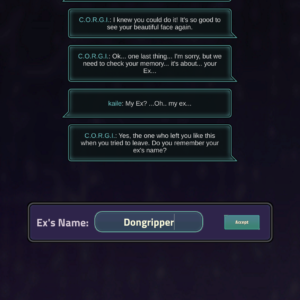DISCLAIMER: I received the demo for this review from Player Two PR. The demo is from an early-access build of the game, and the game developer, Crispy Creative, is starting a Kickstarter today. Thus, all content in this preview is subject to change, and may not be relevant to a future version of the game. Also, consider the first 20 minutes of the game (as it shows up here) spoiled.
A Long Journey to an Uncertain End opens, as many narrative-driven adventure games and western RPGs do, with the player character regaining consciousness, changing their appearance, and discovering they have retrograde amnesia. What makes A Long Journey… somewhat different in that regard is the extent to which this trope plays out, and the reasons it has for playing out in this exact way.
As our character wakes up, a virtual assistant named C.O.R.G.I. (who, of course, takes the form of a Welsh Corgi) asks us to confirm our name and the pronouns we wish to go by. For example, I used my real name and pronoun set, and the game displays it first as “Kaile: they/them/their/theirs” and then just “Kaile: they/them.” There’s also your typical binary choice: “he/him” and “she/her,” and a “custom” option that lets you use the pronouns for any xenogender under the sun. It’s pretty cool.
Once you confirm all of this, C.O.R.G.I. guides you to the character creator, where you can fine-tune your character’s appearance in everything from the fully mix-and-matchable body types down to the exact-pixel position of the eyebrows. Finishing your character makeover will start the game proper, and it immediately becomes apparent why this is significant.
See, your character is not a “person” in the flesh, but a sentient A.I. inside of a starship, and you are on the run from the galactic authorities on account of you are not exactly permitted to exist, legally. Your crew is a rag-tag, diverse bunch of misfits you seem to have gathered from all over, if only you could remember them; we are entering the story in medias res, of course, and something bad has happened that has essentially wiped our recollection of past events. The character you have made seems to serve two purposes: to balance your unstable systems and provide an avatar for the crew to interact with you more comfortably.

After a quick tutorial involving sending your mechanic, Aylah, out on a mission to free your ship-self from imprisonment, you’re in the game and headed for Spacer’s Folly, a quiet outpost on a desert planet far away from the “Ex” you’re fleeing from. And here we are faced with two things almost immediately: the strength of the narrative and characterization, even this early on in development, and how distinct the shape of the gameplay is.
I have to admit being a little bit intimidated by the game when I first heard it would mostly involve resource management, but so far, in my two playthroughs, I’ve experienced nothing but delight. The art rules, every character is fleshed out and has their own personality, and each interaction – every mission you send your crew out on – has the possibility of going in unexpected directions, thanks to some interesting TTRPG-like scenario mechanics that remind me a little bit of games like Monster of the Week and Blades in the Dark.
As you fly from planet to planet, you’ll get pulled into dialogue scenes where a character tells you a little about themselves, and specifically what they want out of their journey with you. Giving them what they want will raise their happiness, whereas failing missions and engaging too many thruster boosts on the journeys between worlds will lower their happiness, so the onus is on you to balance everyone’s needs with the fuel and supply levels onboard.

Sadly, this is just a very short demo of the game, and thus my excitement for how it pans out was frustrated by its boundaries, but what’s here to begin with has me very interested, and frankly a little surprised at its quality.
Perhaps I shouldn’t be surprised at what’s here already – the founder of Crispy Creative, Kylan Coats, was a senior UI designer at Obsidian, and other members of the team come from both Obsidian and the late Telltale Games. But this still easily jumps to the top of my list of most-anticipated games of 2021.
For more info about the game, check out its Kickstarter here.





